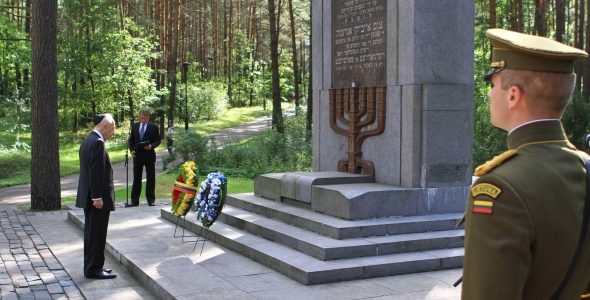
Then-president of Israel Shimon Peres at Ponar in 2013. Photo: AFP/Scanpix
Vilnius, March 27, BNS–The mass murder site established by Nazi Germany in Ponar outside Vilnius during World War II was three times larger than the memorial complex there now, Lithuanian historians have discovered.
“The memorial is only a small part of the Ponar murder operation site. It might have covered 65 hectares, but the memorial complex/museum there occupies 19 hectares,” Lithuanian History Institute researcher Saulius Sarcevičius told BNS Monday. He said researchers working at the site since last year have discovered five new mass murder pits and additional research is being carried out on two of them.
The results of the investigation will help form the foundation in decisions about how to commemorate the mass murder site where about 100,000 people, mainly Jews, were murdered during World War II.
Proposal to Preserve Land Contours
The Lithuanian History Institute began a deeper investigation of Ponar last year attempting to determine what parts of the site need to be preserved. Sarcevičius said the studies revealed new information about trenches, the drainage system and earth-works which revealed how people were murdered. Historians will recommend to archaeologists the latter preserve the contours of the land and certain trees at the site.
“The contours of the land overgrown with bushes and trees reflect to processes of murder at that time. In refurbishing the memorial, the relief of the landscape itself, the pits and hollows and even some trees will need to be preserved. Some of the trees are burnt, and we raised the hypothesis the bonfires for burning corpses were lit next to the trees,” the historian said.
Research at Ponar continues and the Lithuanian History Institute plans to present its final findings in May. Last year a group of investigators from abroad announced they had uncovered the escape tunnel at Ponar.
A Hundred Thousand Victims
When the Germans occupied Lithuania in June of 1941 they chose an unfinished liquid fuel storage facility near the Ponar railroad station as their site for mass murder. The mass shooting of Jews began in July that year.
The German security police and the Special Unit or Ypatingasis būrys subordinate to them, made up mostly of Lithuanians, shot the victims. It has been calculated more than 100,000 people were murdered at Ponar between 1941 and 1944, and the number of Jewish victims is thought to be around 70,000. Other victims included Communists, Soviet POWs, Roma, ethnic Poles and ethnic Lithuanians.
The Ponar Memorial Complex was established in 1960 but the Soviet government wasn’t interested in emphasizing the Jewish Holocaust. A statue from the era still stands at Ponar with the inscription “to the victims of fascism.” After Lithuanian independence new monuments were erected, including the main one with inscriptions in Yiddish, Hebrew and Lithuanian.
The Ponar Memorial Complex is part of the Vilna Gaon State Jewish Museum and the small museum exhibit at Ponar was partially updated in 2009. There are plans to refurbish the entire site with financing from Lithuania and EU support funds over the next few years.
![]()

